Eumorpha anchemolus
|
|
Updated as per
AN ANNOTATED CHECKLIST OF THE SPHINGIDAE OF BOLIVIA, October 2007
Updated as per http://www.pybio.org/SPHINGINAE.htm (Paraguay), October 2007
Updated as per More, Kitching and Cocucci's Hawkmoths of Argentina 2005, October, 2007
Updated as per http://biological-diversity.info/sphingidae.htm (Belize), November 2007
Updated as per Fauna Entomologica De Nicarauga, November 2007
Updated as per The Known Sphingidae of Costa Rica, November 2007
Updated as per personal communication with Jose Monzon (Guatemala); May 2009
Updated as per personal communication with Rodrigo Torres Núñez (Sumapaz (near Bogota), Colombia); July 19, 2010
Updated as per personal communication with Humberto Calero Mejia (PNNG, Isla Gorgona, Cauca, Colombia, May 27, 2011); October 12, 2011
Updated as per personal communication with Ben Trott (Playa del Carmen, Quintana Roo, Mexico); February 26, 2012; January 4, 2013
Updated as per personal communication with Sergio D. Ríos Díaz in CATÁLOGO DE LOS SPHINGIDAE (INSECTA: LEPIDOPTERA) DEPOSITADOS EN
EL MUSEO NACIONAL DE HISTORIA NATURAL DEL PARAGUAY; sent to me in July 2014 by Sergio D. Ríos Díaz.
Updated as per personal communication with Gregory Nielsen (Meta, Colombia); December 22, 2014
Updated as per personal communication with Mildred Brown (Costa Mayo, Quintana Roo, Mexico); February 16, 2015
Updated as per personal communication with Tony James (Gamboa, Panama, Panama, April 22, 2015); May 6 2015
Updated as per personal communication with Galerita Janus (Eumorpha anchemolus, Cerro Jefe, Panama, Panama, July 4, 2016, 900m); March 13, 2020
|
Eumorpha anchemolus
you-MOR-fuhMAN-keh-muh-lus
(Cramer, 1779)
Sphinx
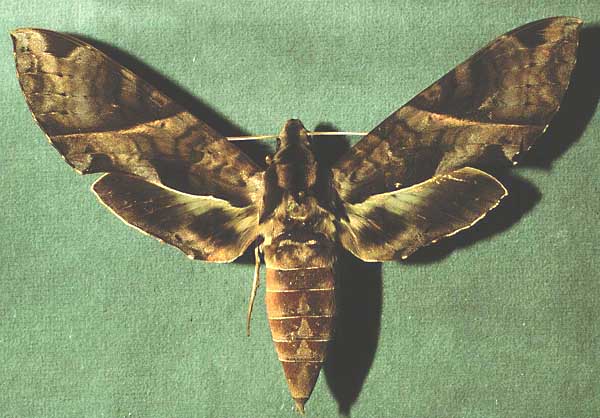
Eumorpha anchemolus female courtesy of Dan Janzen.
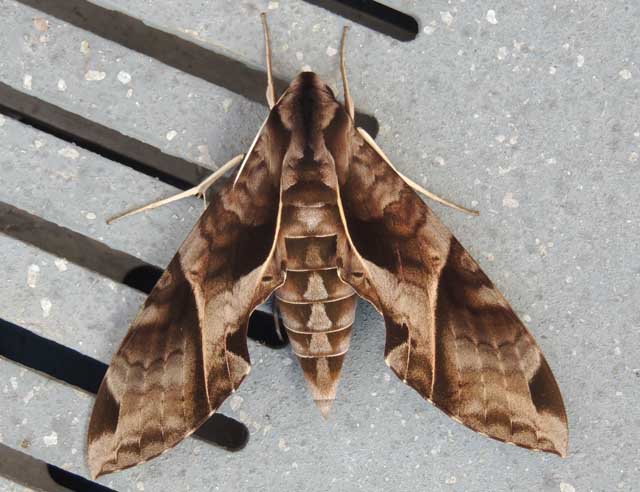
Eumorpha anchemolus, Costa Mayo, Quintana Roo, Mexico, February 15, 2015,
courtesy of Mildred Brown.
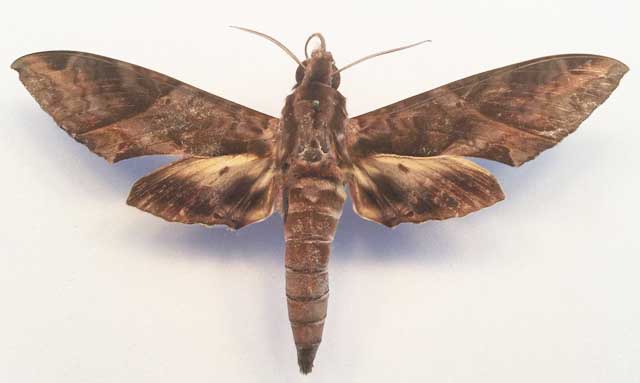
Eumorpha anchemolus, 142mm, Cerro Jefe, Panama, Panama,
July 4, 2016, 900m, courtesy of Galerita Janus, id by Bill Oehlke
This site has been created by Bill Oehlke.
Comments, suggestions and/or additional information are welcomed by Bill.
| TAXONOMY:
Superfamily: Sphingoidea, Dyar, 1902
Family: Sphingidae, Latreille, 1802
Subfamily: Macroglossinae, Harris, 1839
Tribe: Philampelini, Burmeister
Genus: Eumorpha, Hubner, [1807]
Species: anchemolus, (Cramer, 1780) |
DISTRIBUTION:
Eumorpha anchemolus,
(Anchemola Sphinx Moth), (wing span: males: 97-139-[165mm (HCM)]; females: 109-145mm)
has a specimen type locality in
Suriname.
This species also flies in
Venezuela;
Guyana;
French Guiana;
Brazil: Amapa, Amazonas, Para, Mato Grosso (JVB), Rio de
Janeiro, Sao Paulo, Parana, possibly Santa Catarina;
Colombia: Sumapaz (RTN), near Bogota; PNNG, Isla Gorgona, Cauca (HCM), Meta (GN)
Ecuador: Napo (jpl), Orellana;
Peru;
Bolivia: Santa Cruz, Cochabamba (350-750m);
Paraguay: Asuncion, Boqueron, possibly?? Itapua
(WO??);
Argentina: Misiones;
north through Central America to
southern Mexico: Sinaloa; Quintana Roo (BT/MB); Veracruz;
Belize: Corozol; Cayo; Toledo;
Guatemala: Izabal (JM);
Honduras: Francisco Morazan;
Nicaragua: Jinotega; Rio San Juan; Rivas;
probably Matagalpa; Boaca; Chontales;
Costa Rica: Guanacaste; Puntarenas; Limon;
Alajuela; Heredia; San Jose; Cartago;
Panama: Kuna Yala, Panama: Gamboa (TJ); Panama: Cerro Jeffe, 900m (GJ); Rando Frio, Darien NP, Darien, 125m (GJ).
Stragglers sometimes appear in Texas. The North Dakota listing is based on a specimen imported on some bananas.
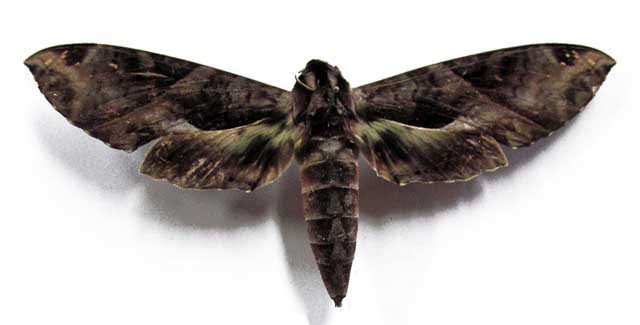
Eumorpha anchemolus, Sumapaz (near Bogota), Colombia, courtesy of Rodrigo Torres Núñez.
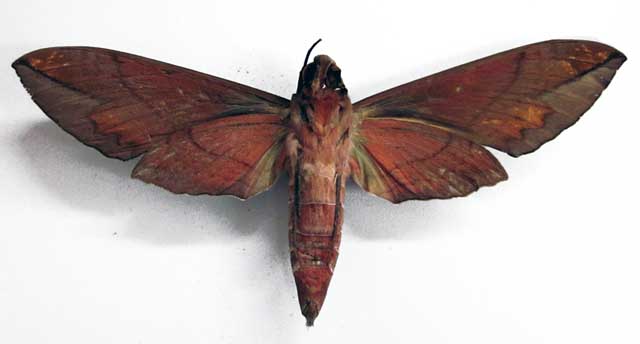
Eumorpha anchemolus (verso), Sumapaz (near Bogota), Colombia, courtesy of Rodrigo Torres Núñez.
The moth's upperside is dark brown. The forewings have diffuse lighter markings, a lighter patch near the center of the inner margin, and often a
single dark spot at the end of the cell.
The dark, preapical, trapezoidal area beginning along the costa does not extend beyond the next vein as it does in E. triangulum.
The forewing outer margin is slightly crenulated. This species is similar to Eumorpha triangulum, but the forewing upperside
pattern is less contrasting and variegated. The dark subapical costal patch is truncated on Rs4.
The white fringe along the inner margin from the body to slightly beyond the median rhombiform patch is very conspicuous. CATE
Eumorpha anchemolus, Yasuni, Ecuador, (September 10, 10:31 PM) in typical resting postion. Image, copyright, courtesy of Steve Graser.
| 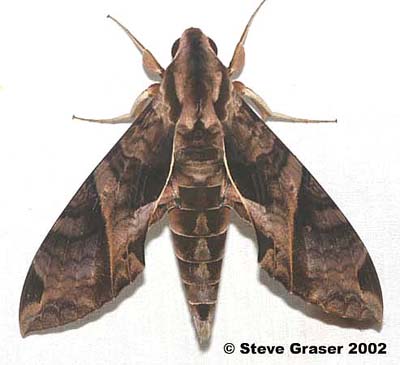 |
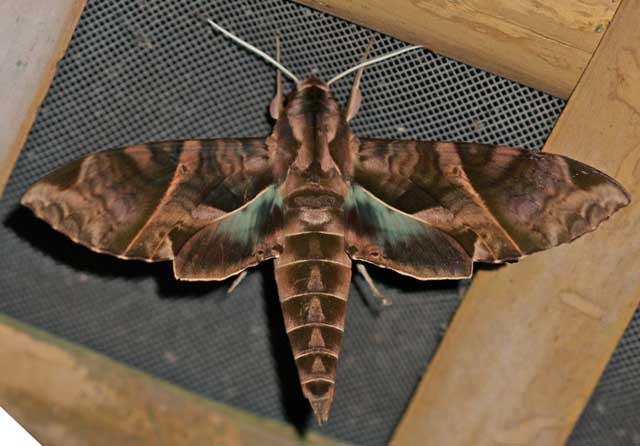
Eumorpha anchemolus, Napo Wildlife Center (00 31 29 S, 076,26 24 W), Ecuador,
July 4, 2010, 220 meters, photographed by Jean-Paul Lenglet, submitted by Gerard Boulay,
tentative id and slight digital repair by Bill Oehlke.
The genus name "Eumorpha" means well-formed.
In Greek mythology, Anchemolus was an ally of Turnus during the war against Aeneas. He was killed by Pallas.
The pronunciation of scientific names is troublesome for many. The "suggestion" at the top of the page is
merely a suggestion. It is based on commonly accepted English pronunciation of Greek names and/or some fairly well accepted "rules" for latinized scientific names.
The suggested pronunciations, on this page and on other pages, are primarily put forward to assist those who hear with internal ears as they read.
There are many collectors from different countries whose intonations and accents would be different.
FLIGHT TIMES AND PREFERRED FOOD PLANTS:
Eumorpha anchemolus adults are on the wing in all but the
coldest months. Humberto Calero Mejia reports a May flight in PNNG, Isla Gorgona, Cauca, Colombia.
Sergio Rios Diaz confirms a December flight in Paraguay. Gregory Nielsen reports a December flight in Meta, Colombia. Tony James reports an April 22, 2015 flight
in Gamboa, Panama, Panama. Galerita Janus reports an early July flight in Cerro Jefe, Panama, Panama, as well as an early March flight in Darien, Panama .
Visit Eumorpha anchemolus, Gamboa, Panama, Panama, April 22, 2015, courtesy of Tony James.

Eumorpha anchemolus, Meta, Colombia,
December 22, 2014, courtesy of Gregory Nielsen.
Adults nectar at various flowers. Eumorpha anchemolus larvae probably feed upon grapes
(Vitaceae), dogbane (Apocynaceae), or evening primrose (Onagraceae)
families.
Cissus erosa and Vitis are reported hosts
in Brazil. Members of Dilleniaceae and Vitaceae families will probably work.
Ben Trott observes in Playa del Carmen, Quintana Roo, Mexico: "E. anchemolus larvae feed primarily on Cissus gossypifolia, but can also be found on
C. rhombifolia and C. erosa."
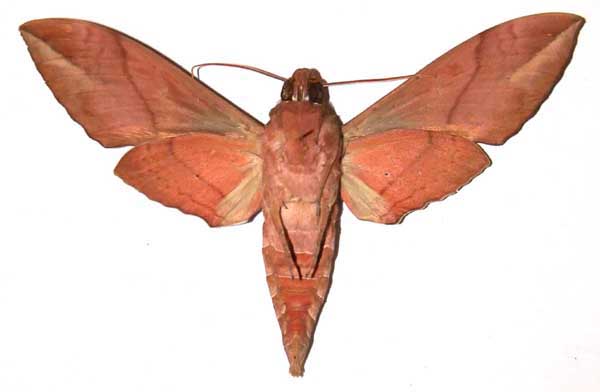
Eumorpha anchemolus, male (verso), 119mm, Costa Rica, courtesy of Dan Janzen.
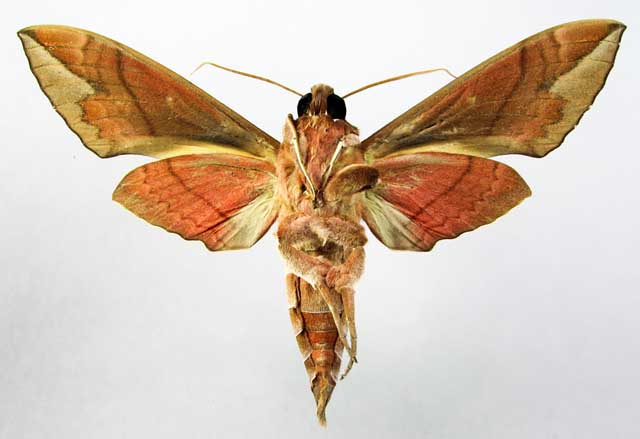
Eumorpha anchemolus (verso) Villavicencio, Meta, Colombia,
forewing length: 60mm, February 1, 2012, 500m,
courtesy of Gregory Nielsen, id by Bill Oehlke.
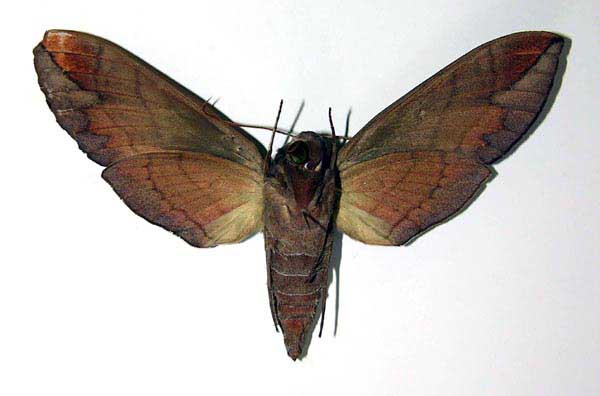
Eumorpha triangulum female, 114mm, verso, courtesy of Dan Janzen.
Images of the ventral surface of E. triangulum on Dan Janzen's pages consistently show a greenish-grey cast to the forewing basal and median areas and
an orangey brown cast to a preapical area just below the costa. The terminal area is also purplish grey, in strong contrast to the rest of the wing.
Images of the ventral surface of E. anchemolus on Dan's pages, show a much reduced, lighter "greenish" area and a much more uniform reddish
cast to the rest of the wing, including the terminal area. I have included a ventral image of E. triangulum for comparison.
ECLOSION, SCENTING AND MATING:
Pupae wiggle to surface
just prior to eclosion. Females call at night, and males (below) fly
into the wind to pick up and track the pheromone plume.
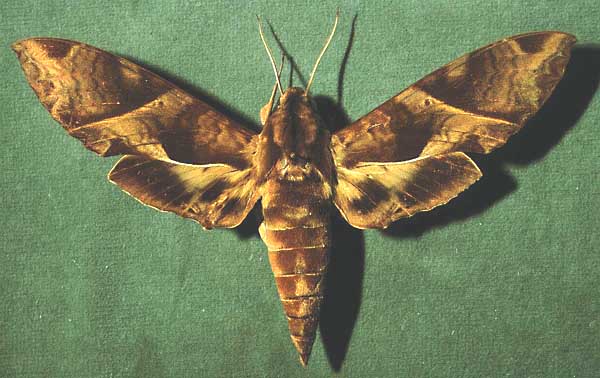
Eumorpha anchemolus male courtesy of Dan Janzen.
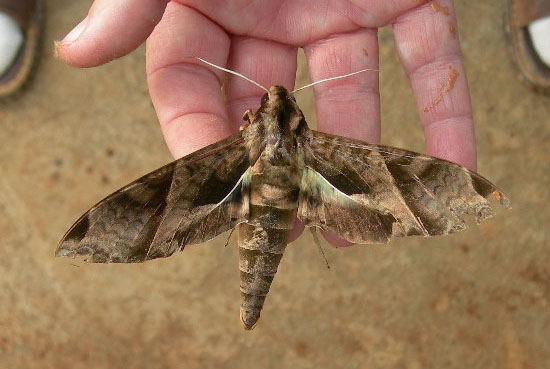
Eumorpha anchemolus, Minas Gerais, Brazil, courtesy
of Larry Valentine.
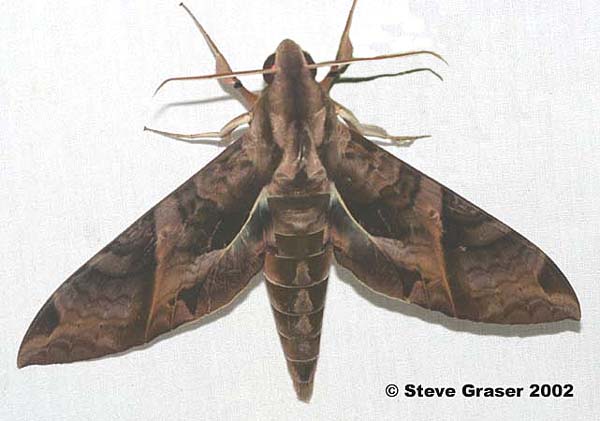
Eumorpha anchemolus, Ecuador, courtesy of Steve Graser.
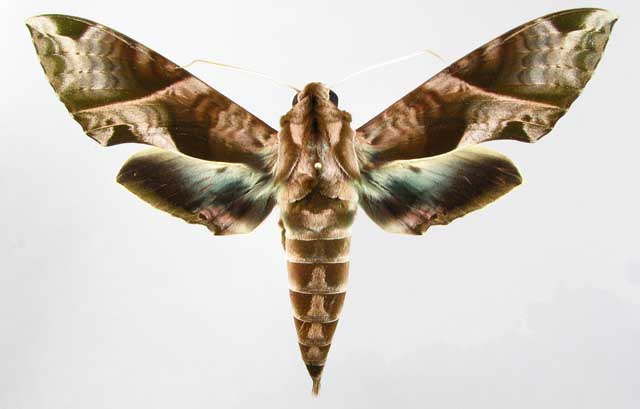
Eumorpha anchemolus Villavicencio, Meta, Colombia,
forewing length: 60mm, February 1, 2012, 500m,
courtesy of Gregory Nielsen, id by Bill Oehlke.
EGGS, LARVAE AND PUPAE:
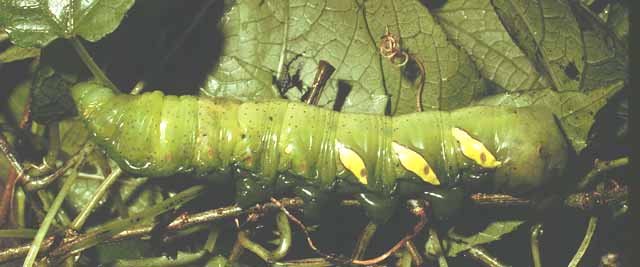
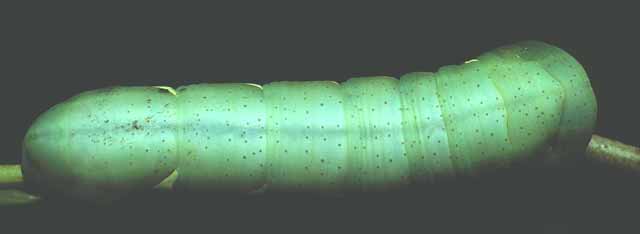
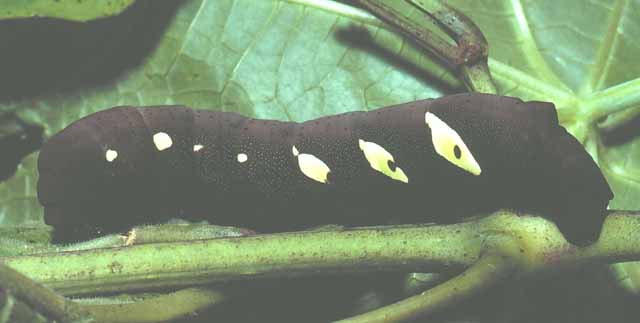
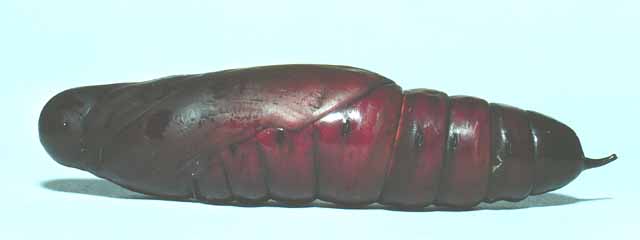
All images above courtesy of Dan Janzen, Costa Rica.
Ben Trott sends me the following report and images from Quintana Roo, Mexico: "Eumorpha anchemolus (x1). This larva was huge. It was 15cm long and just over 3cm thick.
I found it on a thick stemmed vine, I cannot find the name of this plant anywhere, the leaves are the same shape as those of Vitis, but much thicker & shiny, just
like ivy. It must be the primary foodplant here as I have found more evidence of larvae under this same vine. This species annoints itself and does not weave a
cocoon prior to pupation. It chews leaf matter into a paste in order to create an above-ground chamber. The pupa is 7cm long. A spectacular species."
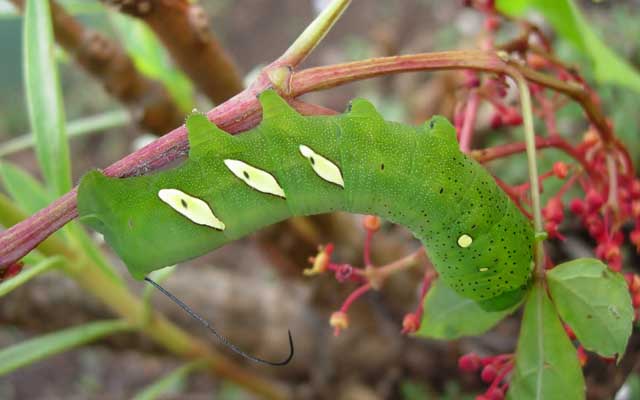
Eumorpha anchemolus fourth instar, green form, Playa del Carmen, Quintana Roo, Mexico,
December, 2012, courtesy of Ben Trott.
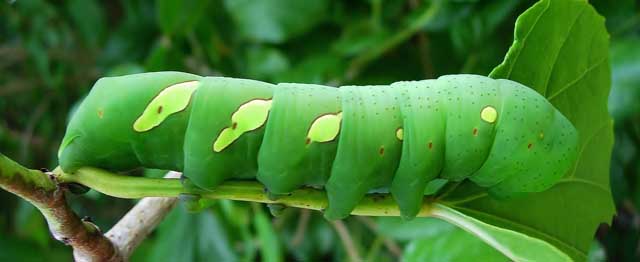
Eumorpha anchemolus fifth instar, Playa del Carmen, Quintana Roo, Mexico,
courtesy of Ben Trott.
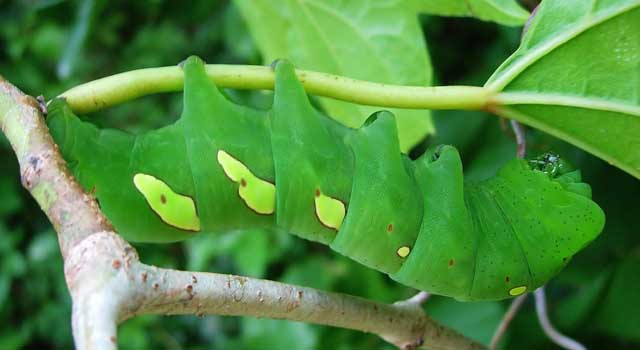
Eumorpha anchemolus fifth instar, Playa del Carmen, Quintana Roo, Mexico,
courtesy of Ben Trott.
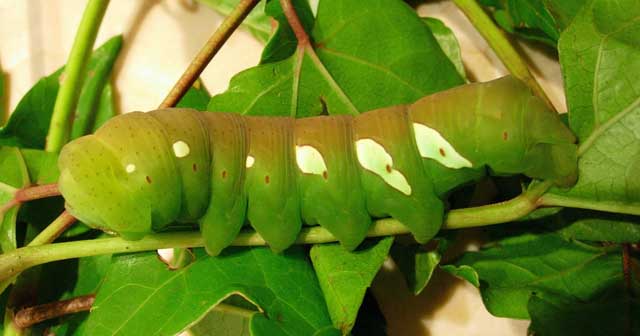
Eumorpha anchemolus prepupal fifth instar, Playa del Carmen, Quintana Roo, Mexico,
courtesy of Ben Trott.
Regarding the following images, Ben Trott writes, January 13, 2013,
"The larva in the photos was found during its 3rd instar on the 9th November and is identical to E. triangulum at this stage, as far as I can tell.
The 4th instar when fully fed measures 60-65mm, and the 5th instar fully fed can measure anywhere between 140 & 160mm (fully extended). The larva produced an
88mm pupa, and a perfect female on the 28th December with 75mm forewings with a wingspan of 165mm approx. The egg was probably laid during the last week of
October, so the life cycle of this species is just over 2 months."
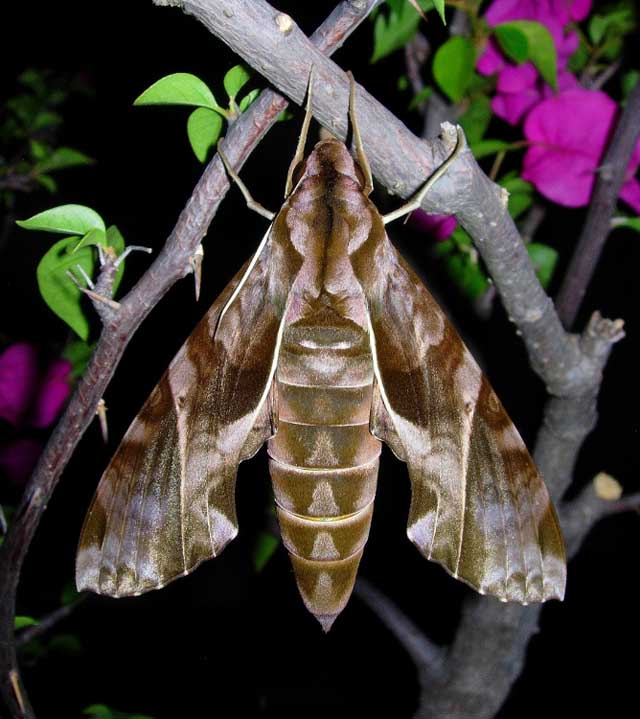
Eumorpha anchemolus female, Playa del Carmen, Quintana Roo, Mexico,
December 28, 2012, courtesy of Ben Trott.
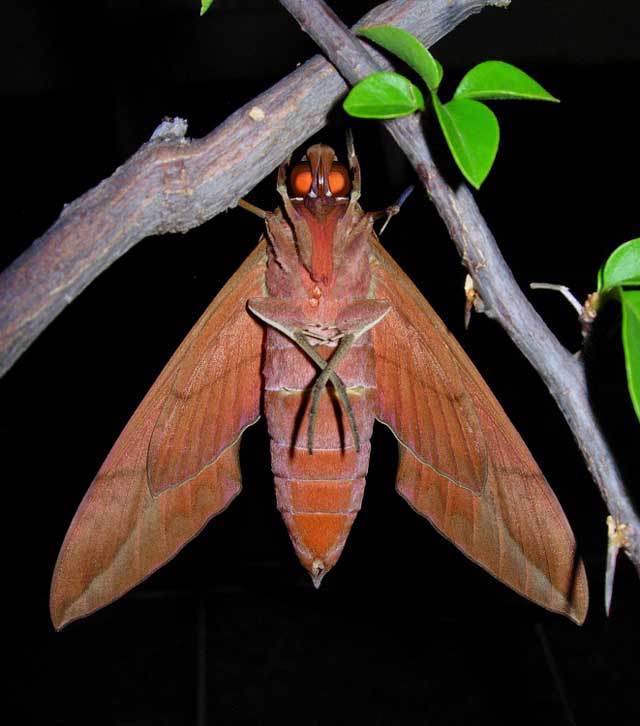
Eumorpha anchemolus female (verso), Playa del Carmen, Quintana Roo, Mexico,
December 28, 2012, courtesy of Ben Trott.
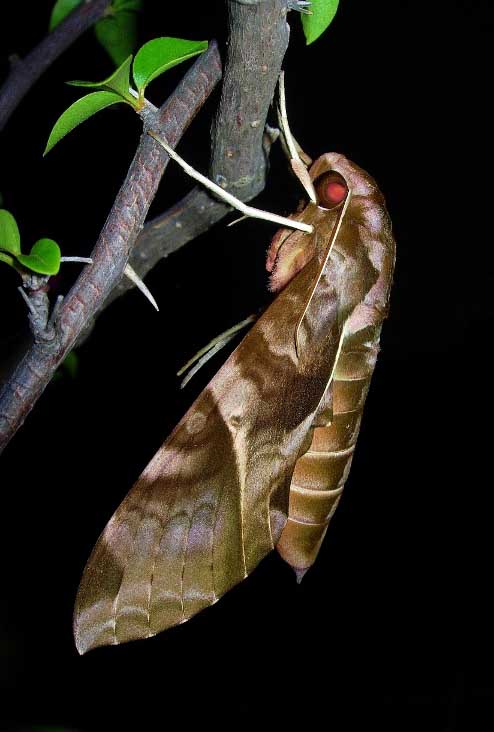
Eumorpha anchemolus female (lateral), Playa del Carmen, Quintana Roo, Mexico,
December 28, 2012, courtesy of Ben Trott.
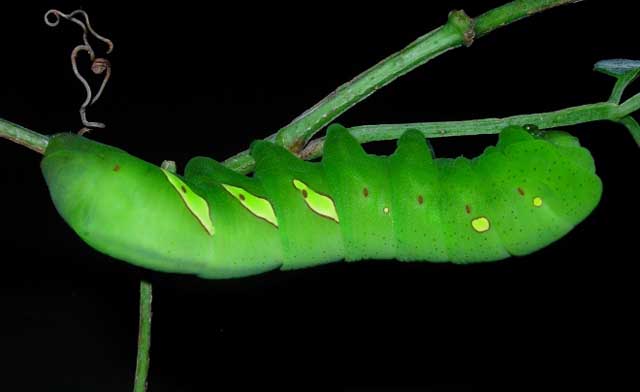
Eumorpha anchemolus green form fifth instar, Playa del Carmen, Quintana Roo, Mexico,
courtesy of Ben Trott.
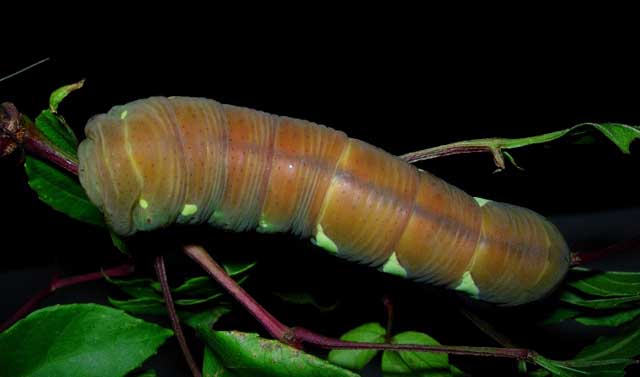
Eumorpha anchemolus prepupal fifth instar, Playa del Carmen, Quintana Roo, Mexico,
courtesy of Ben Trott.
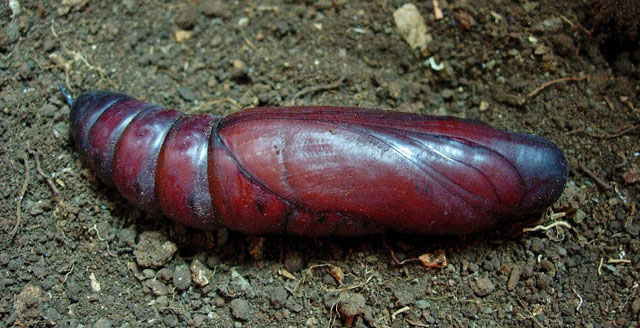
Eumorpha anchemolus female pupa, Playa del Carmen, Quintana Roo, Mexico,
courtesy of Ben Trott.
Ben Trott observs, "I can only say that the pupation date must have been the 30 Nov. as the larva burrowed on the 26th.
I count a day for it to 'construct' the pupation chamber and 3 days to pupate." Moth emerged approximately four weeks after pupation.
Larval Food Plants
Listed below are primary food plant(s) and alternate food plants. It is hoped that this alphabetical listing followed by the
common name of the foodplant will prove useful. The list is not exhaustive. Experimenting with closely related foodplants is
worthwhile.
Cissus alata
Cissus aff. biformifolia.......
Cissus erosa
Cissus gossypifolia (BT)
Cissus pseudosicyoides
Cissus rhombifolia (BT)
Vitis
|
Cissus alata
Cissus aff. biformifolia
Caro de tres hojas
Cissus gossypifolia (BT)
Treebine
Oak Leaf ivy
Grape
|
Use your browser "Back" button to return to the previous page.
Return to U. S. A. Table
Return to Philampelini Index
Return to Sphingidae Index
Use your browser "Back" button to return to the previous page.
This page is brought to you by Bill Oehlke and the
WLSS. Pages are on space rented from Bizland. If you would like to become a "Patron of the Sphingidae Site", contact Bill.
Please send sightings/images to Bill. I will do my best to respond to requests for identification help.
Enjoy one of nature's wonderments: Live Saturniidae (Giant Silkmoth) cocoons.
 | 
Show appreciation for this site by clicking on flashing butterfly to the left.
The link will take you to a page with links to many insect sites. |






























